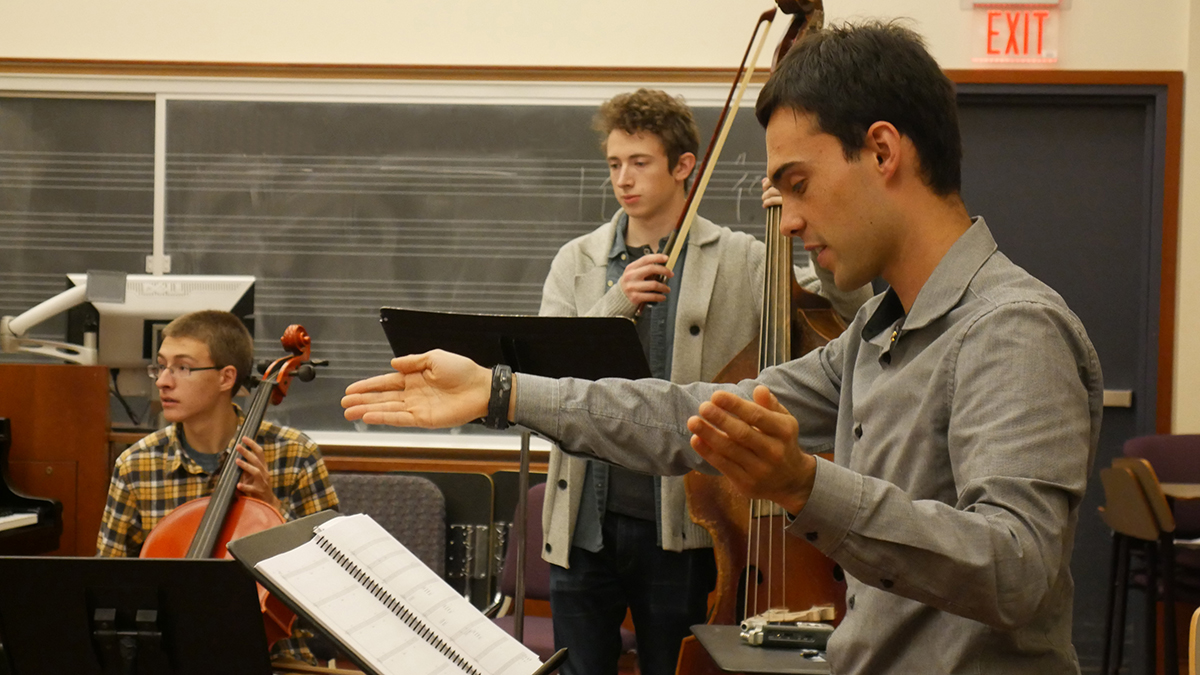Architecture meets mythology in opera by Patrick Braga '17
By Daniel Aloi

Patrick Braga ’17 has brought his academic interests in urban planning, architecture and music together in his latest opera, “Eyes That Do Not See (Opus 42).”
Based on the work and ideas of the architect Le Corbusier, and using the myth of Prometheus as a narrative framework, the opera premieres with a free performance Nov. 11 at 8 p.m. in the Milstein Hall dome.
“One of my professors was trying to encourage me and said, ‘You should try writing an urban opera.’ Because urban planning can be very dramatic – you go to any city hall meetings, any of these moments can be part of a dramatic narrative,” Braga said. “City planning is something that touches peoples’ lives in a really deep way. ... People have very deep, vested personal interests in how their environments are shaped.”
The figures of Le Corbusier and Prometheus intersect “to explore the themes of unseeing eyes, the introduction of light into spaces and the unintended consequences of technology,” according to Braga.
The production, sung in English and French, features multimedia, a 12-piece chamber orchestra, two dancers and a five-voice women’s choir.
“They play simultaneously the role of a traditional Greek dramatic choir, but also take on roles jointly throughout,” Braga said. “Sometimes they play the Furies, or they all play Zeus – all five being one character.”
In the dual role of Le Corbusier and Prometheus is tenor soloist Jonathan Fisher ’17, a human development major in the College of Human Ecology.
Braga is a fifth-year undergraduate majoring in urban and regional studies in the College of Architecture, Art and Planning, and music and economics in the College of Arts and Sciences. A Hunter R. Rawlings III Cornell Presidential Research Scholar and Mellon fellow, he recently traveled to Cuba as part of the fall 2016 Mellon Collaborative Studies in Architecture, Urbanism and the Humanities expanded practice seminar.
In addition to Havana, his urban studies research has focused on ideas of modern architecture, their implementation and architectural practice in Boston, Washington, D.C. and his home city, Rio de Janeiro.
In music, Braga’s focus is composition. His first opera, “La Tricotea,” was performed last December in Barnes Hall.
His presidential research scholarship supported a project on mobile ethnography and “transportation and its intersection with social practice and the law,” he said, in a study of the Boston Cyclists’ Union, a nonprofit advocacy group, two summers ago.
While in Boston, he came across the city’s comprehensive plan from 1965. “I use a couple of lines from that in the opera,” he said, to show Le Corbusier outlining the use of arterial streets or highways through a city.
“I drew inspiration from a really wide palette,” he said.
Accompanied by images of Le Corbusier’s work, and video of midcentury urban renewal in Boston, Detroit and other cities, the opera draws from numerous sources – including early neoclassical music in a passage inspired by C.P.E. Bach, Percy Bysshe Shelley’s lyrical drama “Prometheus Unbound,” Greek dramatist Aeschylus and “a Portuguese epic poem called ‘The Lusiads,’” he said, the latter with Vasco da Gama as main narrator.
“I was originally planning on writing a dramatic cantata about when the Portuguese explorer da Gama goes around the Cape of Good Hope and meets all these monsters,” Braga said. “So I just took the music and reused it. It’s a small reference, but it is there. It also recognizes the original process of where the music came from.”
A bibliography is included in the event program, and “everyone’s going to get a copy of the libretto to read along,” he said.
Inspired in part by the increasing use of nontraditional spaces for opera, Braga chose the Milstein Hall dome after seeing a performance of Stravinsky’s “The Soldiers’ Tale” there in 2015 during the Department of Music’s Mayfest.
“The acoustics actually worked,” he said. “And what better place to do a work about modern architecture? The building has a lot of references to Le Corbusier himself,” in particular to principles in “The Five Points of a New Architecture.” The walkway across the dome also is part of the opera’s staging, Braga said.
Media Contact
Get Cornell news delivered right to your inbox.
Subscribe